EYE DIGEST
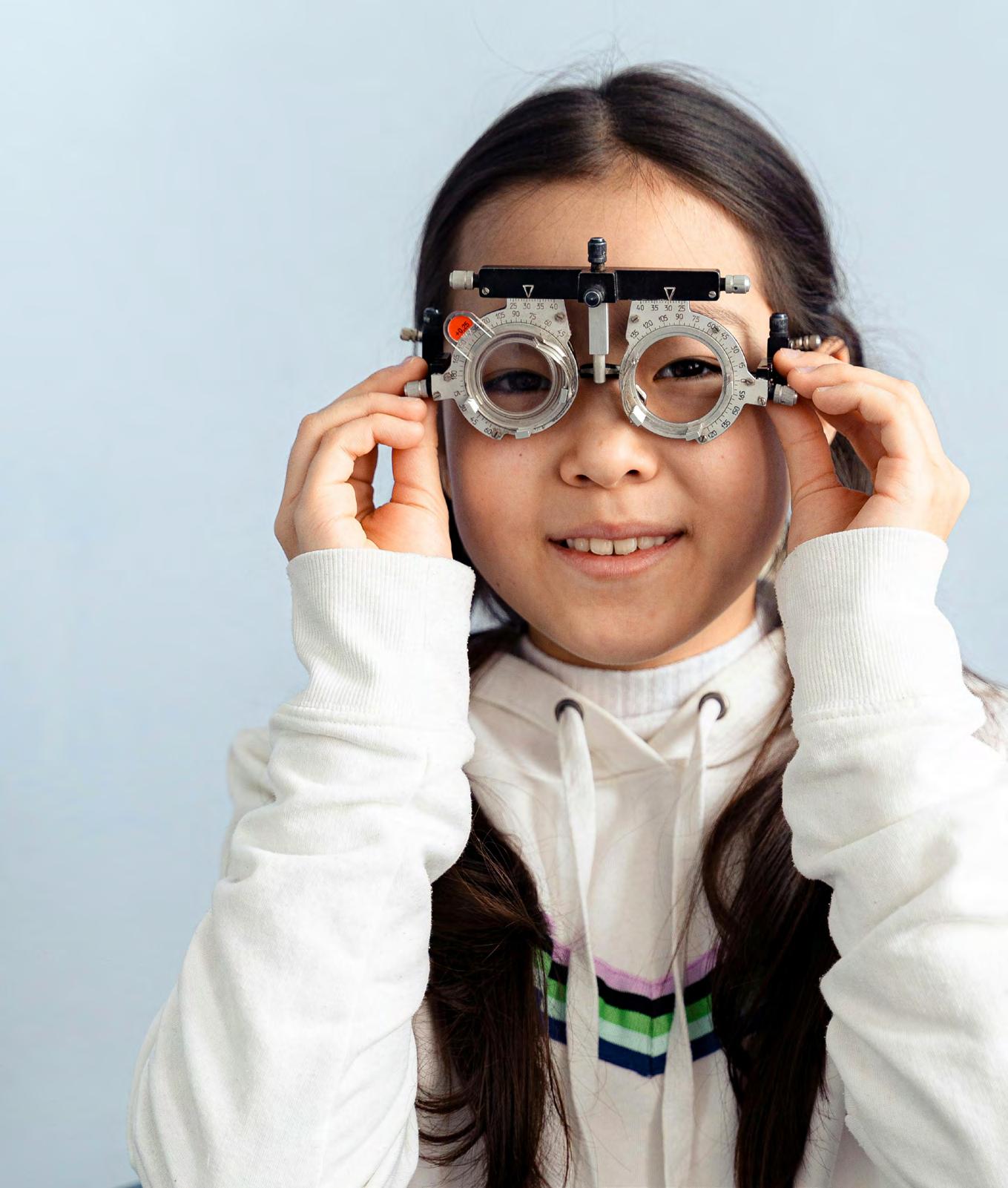


JUNE 2024 BCDO’S QUARTERLY OPTOMETRIC MAGAZINE
BC Doctors of Optometry 121–10551 Shellbridge Way, Richmond, BC. V6X 2W8 info@optometrists.bc.ca | 604.737.9907 Eyes Forward: Patient-Centred Optical Care Meet BCDO’s New President, Dr. Evelyn Lo First Nations Health Authority Offers Comprehensive Vision Coverage p. 4 p. 14 Stuart and Ali: Paying it Forward and Back p. 20


CONTENTS Meet BCDO’s New President, Dr. Evelyn Lo ..................................... 4 Why Toilets Matter: The Unseen Impact on Practice Value .................... 7 Patient Centered Optical Care: Adding Value with Specialty Fit Frames ......................................... 11 First Nations Health Authority Offers Comprehensive Vision Coverage ................................................. 14 Competitive Marketing Strategies For Optometrists .......................... 16 Stuart and Ali: Paying it Forward and Back 20 HOYA Vision Care’s Innovations Enhance Vision and Comfort ............. 22 No More Silent Sufferers ........................................................... 28 The Essence of Patient Care 30 Highlights Reel: BCDO 2024 ....................................................... 34 Optomap: Essential on Every Patient, All Ages, Asymptomatic ............ 40 Eye Digest Magazine | 3

Meet BCDO’s New
President, Dr. Evelyn Lo
1. Why did you choose the field you are in?
I feel like optometry chose me! When I was just 8 years old, my sister’s optometrist detected multiple retinal tears in her eyes. I was amazed at how she could save someone’s vision even when they didn’t have any symptoms. That’s when I became curious about optometry and the rest is history!
2. As BCDO’s President, what’s your favourite part of the role?
The best part of my role is being able to collaborate with like-minded colleagues to achieve common goals and drive our profession forward. It’s incredibly rewarding!
3. What would you like to help BCDO achieve in the near future?
The ability for our colleagues to practice to the fullest scope of their education in order to provide timely and excellent patient care.
4. What are some skills or strengths you bring to the team?
During our last strategic planning meeting, we were asked to identify our strengths. Our fellow board members identified my strengths as motivated, visionary, and possessing strong delegation skills.
5. What is the most valuable career advice you’ve been given?
“The only thing worse than being blind is having sight but no vision”
– Helen Keller
6. What’s your go-to coffee order?
I don’t actually drink coffee, but I do appreciate loose-leaf teas!
7. Where would you like to travel next?
Switzerland!
8. What is an accomplishment you’re proud of?
Hiking to the Top of Europe!
9. How do you like to decompress after a day at the clinic?
Getting outdoors when weather and time permits! Otherwise, you will probably find me playing badminton or building Lego.
10. What are you most looking forward to in 2024?
Starting the Queens and Cornell dual executive MBA and applying the skills I learn back to optometry and BCDO!
Eye Digest Magazine | 5

Why Toilets Matter: The Unseen Impact on Practice Value
By Jackie Joachim
While originally spun from the dental world by Tim Brown, President of ROI Corporation, this story resonates just as profoundly within the realm of optometry.
Reflecting on Tim’s eye-opening narrative, “Why Toilets Matter”, it’s clear that the nuances of the practice environment extend far beyond mere aesthetics or functionality. They’re crucial to the very valuation of an optometric practice.
Here’s a curious tidbit that Tim shared, illustrating the point perfectly: a dental office in an older medical building introduced door codes for bathroom access, changing them occasionally.
Imagine, if you will, a patient viewing this sign!
This isn’t just about security or modernization; it’s a testament to how amenities, as mundane as bathroom access, can significantly impact a practice’s perceived value.
Amenities such as these aren’t just physical attributes; they’re reflections of how a practice
values its staff, patients, and overall operational ethos. And guess what? This wisdom is utterly applicable to the optometry world as well.
Tim draws from a decade of hands-on clinical experience before venturing into the appraisal and valuation arena. He has navigated diverse practice settings, each with its unique challenges and comforts. The conclusion? The quality and availability of facilities like bathrooms genuinely matter.
Imagine the daily grind in an optometry practice – it’s a marathon of mental and physical exertion. From the moment you step through those doors, it’s non-stop. The availability of a private space to catch a moment’s breath between patients isn’t a luxury; it’s a necessity.
Yet, disappointingly, this basic requirement remains elusive in many settings. Consider a working mother returning from parental leave, the absence of a private, comfortable space for necessities like breast milk pumping – relegated instead to a cramped public restroom! Disheartening.
Eye Digest Magazine | 7
Key Point: Minor Details Impact Practice Value
We’ve witnessed firsthand the discomfort of staff and patients sharing a too-close-for-comfort restroom adjacent to the waiting area. The thought of a healthcare professional emerging from such a space, only to engage closely with a patient, underscores a glaring oversight in hygiene and privacy standards.
The dialogue around these issues isn’t new. These seemingly minor details can profoundly affect the morale of your staff, the satisfaction of your patients, and ultimately, the financial valuation of your practice.
In echoing Tim’s sentiments, it’s clear: the gold standard for any healthcare practice, optometry included, must advocate for private bathrooms and a dignified, clean space for staff. Let’s not overlook the basics, for in them lies the foundation of our practice’s value and integrity.
Jackie Joachim has 30 years of experience in the industry as a former banker and now the Chief Operating Officer of ROI Corporation.
Please contact her at Jackie.joachim@roicorp.com or 1-844-764-2020.

8 | Eye Digest Magazine

Eye Digest Magazine | 9
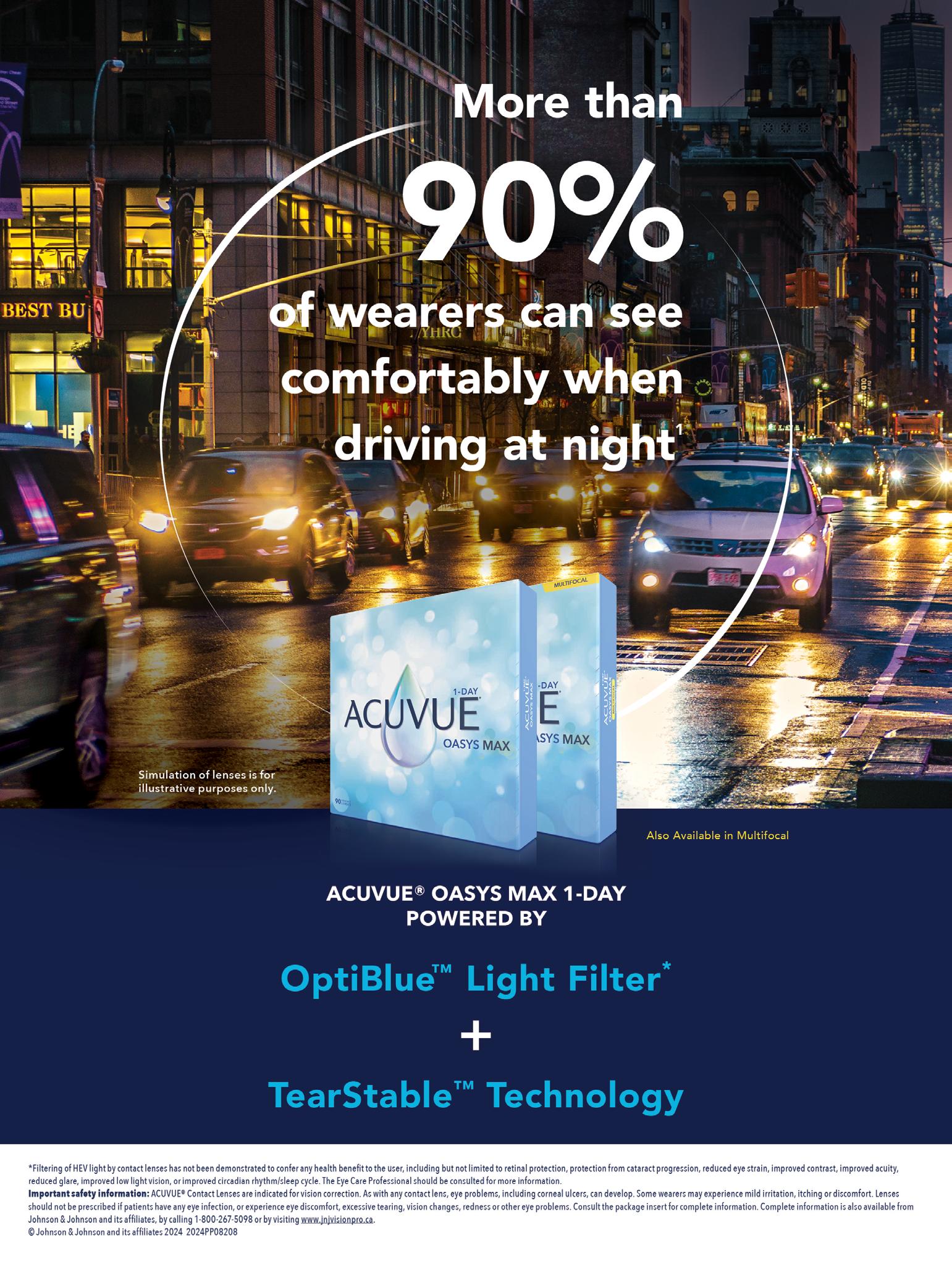
Patient Centered Optical Care: Adding Value with Specialty Fit Frames
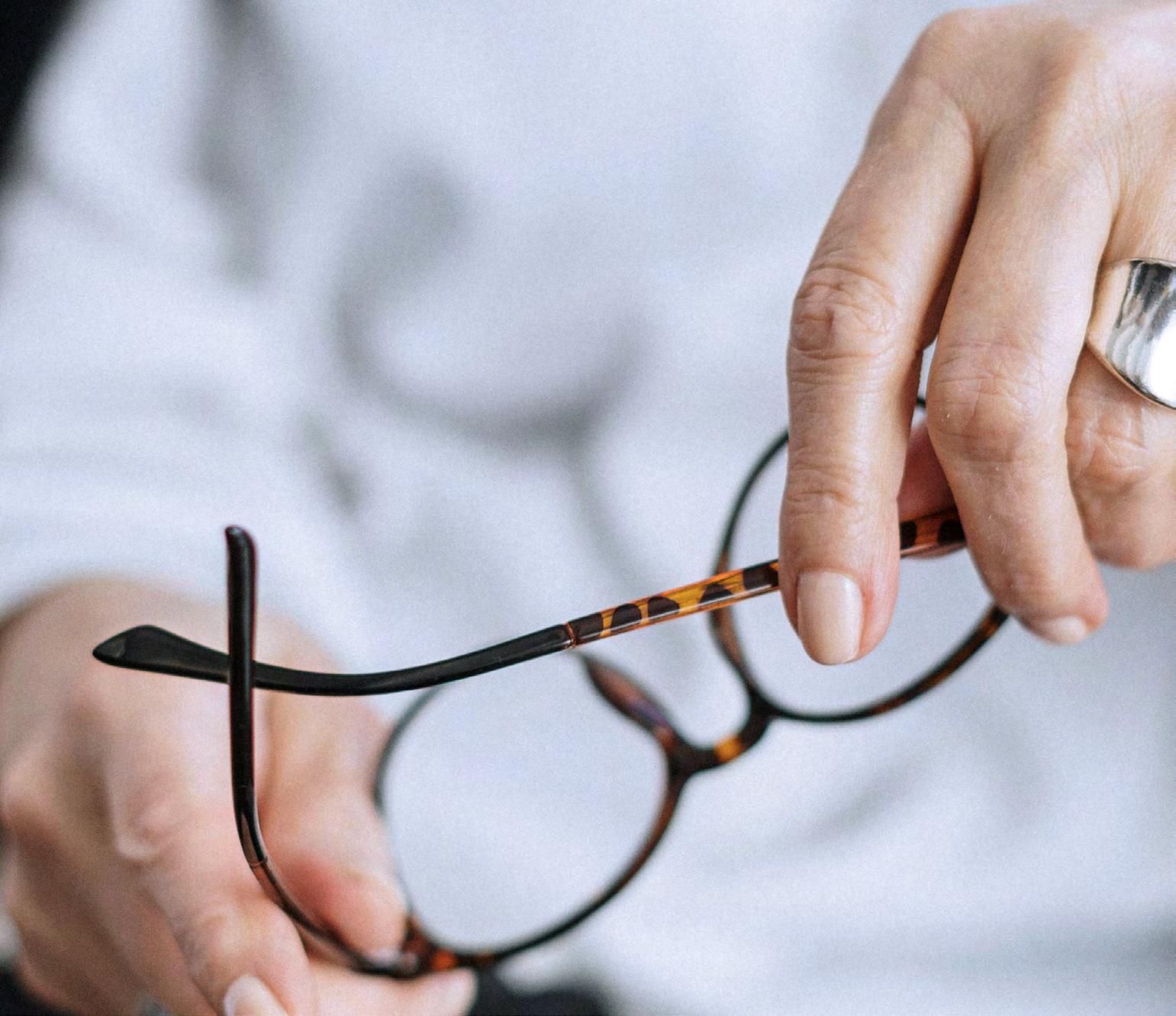
In the realm of optometry, patient-centered care isn’t just about diagnosis and treatment — it’s also about addressing the diverse needs and preferences of each individual.
One significant aspect of this is providing eyewear options that cater to patients of all shapes and sizes. While the optical industry has made great strides in offering a variety of frame styles, there has often been a gap in providing specialty fit frames for patients with larger faces. However, the emergence of collections such as BMEC and GB+ from Modern Optical is changing the landscape of eyewear diversity, enhancing patient-centered optical care by offering a wider range of frames tailored specifically for individuals with larger facial dimensions.
Eye Digest Magazine | 11
BMEC (Big Men’s Eyewear Club) and GB+ are at the forefront of this movement, recognizing the importance of inclusivity and accessibility in eyewear design. These collections are dedicated to providing high-quality, stylish frames that not only accommodate larger head sizes but also ensure optimal comfort, fit, and visual aesthetics. By offering a diverse selection of frames in various styles, colors, and materials, BMEC and GB+ empower patients with larger faces to find eyewear that not only meets their practical needs but also aligns with their personal style preferences.
One of the key benefits of the BMEC and GB+ collections is their focus on specialty fit frames that are specifically engineered to accommodate larger facial dimensions. These frames feature extended temple lengths up to 160mm, eye sizes up to 64mm, and deeper lens heights, ensuring a comfortable and secure fit for patients with broader features. By addressing common fit challenges faced by individuals with larger faces, such as discomfort, pressure points, and slippage, these specialty fit frames enhance the overall wearing experience and promote long-term satisfaction with eyewear.
Moreover, the BMEC and GB+ collections offer a diverse array of frame styles to suit the unique tastes and lifestyles of patients with larger faces. Whether it’s classic designs, contemporary trends, or sporty aesthetics, these collections encompass a wide spectrum of options, allowing patients to express their individuality and confidence through their eyewear choices. From sleek metal frames to bold acetate designs, BMEC and GB+ frames combine style with functionality, empowering patients to find the perfect pair that complements their personality and enhances their visual appeal.
In addition to providing specialty fit frames, the BMEC and GB+ collections prioritize quality and durability, ensuring that patients receive eyewear that not only looks great but also stands the test
of time. High-quality materials such as stainless steel, titanium, and premium acetate are used in the construction of these frames, offering durability, flexibility, and lightweight comfort. This commitment to craftsmanship and reliability reflects the brands’ dedication to delivering eyewear solutions that exceed the expectations of patients with larger faces.
Furthermore, the BMEC and GB+ collections embrace inclusivity and representation, celebrating diversity in all its forms. By featuring models and ambassadors with larger facial dimensions, these brands showcase the beauty and uniqueness of individuals with varying features, challenging traditional standards of beauty and promoting a more inclusive definition of attractiveness. This representation not only resonates with patients who see themselves reflected in the brand’s marketing but also fosters a sense of belonging and acceptance within the larger eyewear community.
In conclusion, the BMEC and GB+ collections are revolutionizing patient-centered optical care by redefining the concept of eyewear diversity. By offering specialty fit frames designed specifically for patients with larger facial features, these collections address a longstanding gap in the optical market and empower individuals to find eyewear that not only fits well but also reflects their personal style and identity. Through their commitment to inclusivity, quality, and representation, BMEC and GB+ are leading the way towards a more inclusive and accessible future for eyewear, where every patient can find the perfect pair of glasses that make them look and feel their best.
To learn more about these collections, please visit Modern Optical’s website at www.modernoptical.com
12 | Eye Digest Magazine
2024 BCDO Member Benefits
$1,500
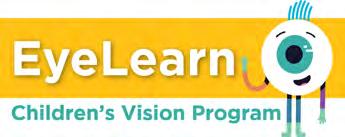
Programs c Funding Opportunities Professional Benefits
Technology, Innovation
Continuing Education
Indigenous
Safety
Rural Access:
travel
rural
BCDO Business Help Desk HR Help Desk Medimaps Liability Insurance through CAO Free CE Opportunities: Virtual & in-person Merchant 1 Payments: Exclusive discount SimpleCPR Online: Re-certification SECO University of Optocase: Partnership Services
Benefits 20% back in commissions from Triunity Mortgage Group 20% discounts at Anytime Fitness Bell Mobility Cell Phone Plan savings Homewood Health Counselling Services Perkopolis Free standard delivery, a ordable financing options, on-site warranty, and accidental damage protection with Dell Technologies Up to 20% o bookings with Hyatt Regency, Fairmont, and Sandman Hotels Discounted tickets with Cineplex Optocase Advocacy MSP Fees Scope of Practice Modernization of Health Profession Recall cards Rx pads Locum list Find-a-Doctor tool MSP Billing Tips Optomart TPA Web App Free PR Collateral
& Equipment Reimbursement $600
Reimbursement $300
Cultural
Training Reimbursement
Reimbursement for
expenses for ODs o ering care in
and remote communities
Personal
For more information, email info@optometrists.bc.ca
First Nations Health Authority Offers Comprehensive Vision Coverage
The First Nations Health Authority (FNHA) offers a wide array of programs and services, including vision care, to over 150,000 First Nations people and 203 communities across BC. The FNHA
works closely with communities and vision care professionals to develop programs that improve access to services, while offering flexibility and aligning with industry best practices.
What does coverage under the FNHA Vision Benefit include?
Service Coverage Notes
$100 for a routine eye exam every two years (annually for those 18 years and under).
This coverage is in addition to the MSP eye exam coverage for those over 65 years and under 18 years of age. MSP coverage should be accessed prior to the FNHA’s coverage. Eye exam
$275 every two years for prescription eyewear ($415 for high index prescriptions).
This includes items such as contact lenses, frames, glasses lenses and prescription sunglasses.
Prescription eyewear
14 | Eye Digest Magazine
To access the FNHA’s vision benefits, eligible First Nations people must first enroll as a Client with First Nations Health Benefits. Clients can access vision care at any BC Optometrist of their choice. They have the option to submit for reimbursement or, for Providers registered with PBC, have their provider bill PBC directly.
Regular eye exams are essential for maintaining good eye health, as they ensure up-to-date prescriptions for glasses and contact lenses, and help to detect any eye and brain diseases. The FNHA works towards improving the accessibility of this care not only by increasing the services that are available to First Nations people across BC, but also working to ensure that this care is culturally safe. Many First Nations people have experienced culturally unsafe care due to the ongoing impacts of colonialism, which can create significant barriers to accessing vision care. It
is important that as Providers continue to work towards offering high quality care, that cultural safety is built into the delivery of these services. To support ongoing learning, the FNHA partnered with Health Standards Organization (HSO) on the British Columbia (BC) Cultural Safety and Humility Standard. A video about the Cultural Safety and Humility Standard is also available here.
For more information about FNHA’s vision benefit or eligibility, please visit the website or call Health Benefits at 1-855-550-5454.

Eye Digest Magazine | 15
Competitive Marketing Strategies For Optometrists
Presented by Scotiabank Healthcare & Professional Banking

As a practising optometrist, you’re a member of an exciting profession.
Canada’s optometry industry has grown in recent years, driven in part by our country’s aging population and increasing demand for eye care services.[1] However, despite the overall health of the industry, optometrists today face increasing competition from online services and other retailers. It’s time to consider clever ways to compete.
Here are some strategies that can help you stay competitive in today’s market:
Train your employees in customer service
While staff training may not come to mind first when you think of marketing, nothing is more
important. Your employees are the face of your clinic. The customer service, or overall client experience, they provide can help you to acquire patients for life. From that first appointment reminder they send out to your patients to that welcoming smile they provide when a patient walks in the door, their support is an essential part of your business.
“Along with providing eye exams, what makes optometry different from many other health services professions is that it has a retail component,” says Eric Laidlaw, Senior Healthcare Professional Specialist at Scotiabank. A study of optometrists’ revenue found that while 39 percent of an optometrist’s revenue typically comes from professional fees, 24 percent most often comes from spectacle lenses and 16 percent from contact lenses.[2] Training staff to provide helpful, consultative advice to patients on selecting the right eyewear or contacts is therefore something Laidlaw says can be one of the most effective marketing strategies.
16 | Eye Digest Magazine
Choose the right location
In today’s marketplace, optometrists are actively competing with online eyewear retailers but one of the advantages you have as an optometrist is that an eye exam requires an in-person visit. This means you have an opportunity to help your patients choose the right product for their needs as soon as you hand them their new prescription.
However, location matters. More people will be aware of your service – and likely to walk in – if they pass by it every day. “It can work well to locate your practice in a busy mall, a business centre with professional traffic or partner with a bigbox retailer to increase the likelihood of people finding you,” says Lily Lu, Professional Banker at Scotiabank. “You can also increase your chance of receiving referrals by locating in the same building as other healthcare providers, especially one where patients go to receive eye treatment from an ophthalmologist,” says Lu.
Offer unique products and services
One of the most effective ways you can stand out from your competitors is by offering unique, differentiated products and services. For example, it is estimated that around 30% of Canadians experience dry eye, a condition where the eye doesn’t produce sufficient tears.[3] “Offering dry eye diagnosis and treatment can therefore help you attract new patients,” says Lu.
If you sell eyewear, the inventory you stock and how you display it also matters. Make sure frames can be easily accessed and available for patients to try on while they are waiting to be served. Also make sure your inventory is kept current and includes a variety of unique styles. There are some large companies in the eyewear market that cover manufacturing to retail, making it harder to differentiate your product and services but some boutiques have managed to carry unique brands over the years to differentiate themselves from the masses. Whether it’s product combinations or the
customized service you provide, finding a way to stand out and differentiate yourself is important.
Invest in new technology
Investing in the right technology can help you stay competitive and ensure your patients receive the most up-to-date standard of care. New computer software can help you to better manage your patients’ medical records, as well as help you stay on top of your finances. Plus, customer relationship management (CRM) software can also enable patients to book appointments directly through your website and send out automatic email or text reminders and follow-up appointment notifications.
New cutting-edge optical technology can also enable you to offer superior treatment and diagnosis. This includes digital retinal imaging technology that can allow you to better assess the health of the back of the eye and computerassisted corneal topography that can enable you to create three-dimensional maps to better detect abnormalities in the of the surface of the cornea.
[4]
“One of the advantages of Scotiabank’s financing when setting up an optometry clinic is purchasing and investing in new technology,” says Lu. “We provide equipment financing for up to 100% of the cost. It’s one way Scotia helps to provide optometrists with a competitive edge.”
For additional information and customized advice and support to help you grow your optometry practice, contact a Scotiabank Healthcare & Professional Specialist today.
1 IBIS World, Optometrists in Canada - Market Size, Industry Analysis, Trends and Forecasts (2023-2028).
2 Review of Optometric Business, What Percentage of Your Revenues Stem from Frame Sales?
3 CNIB, Dry Eye
4 iTrust, What is the latest technology in optometry?
Eye Digest Magazine | 17
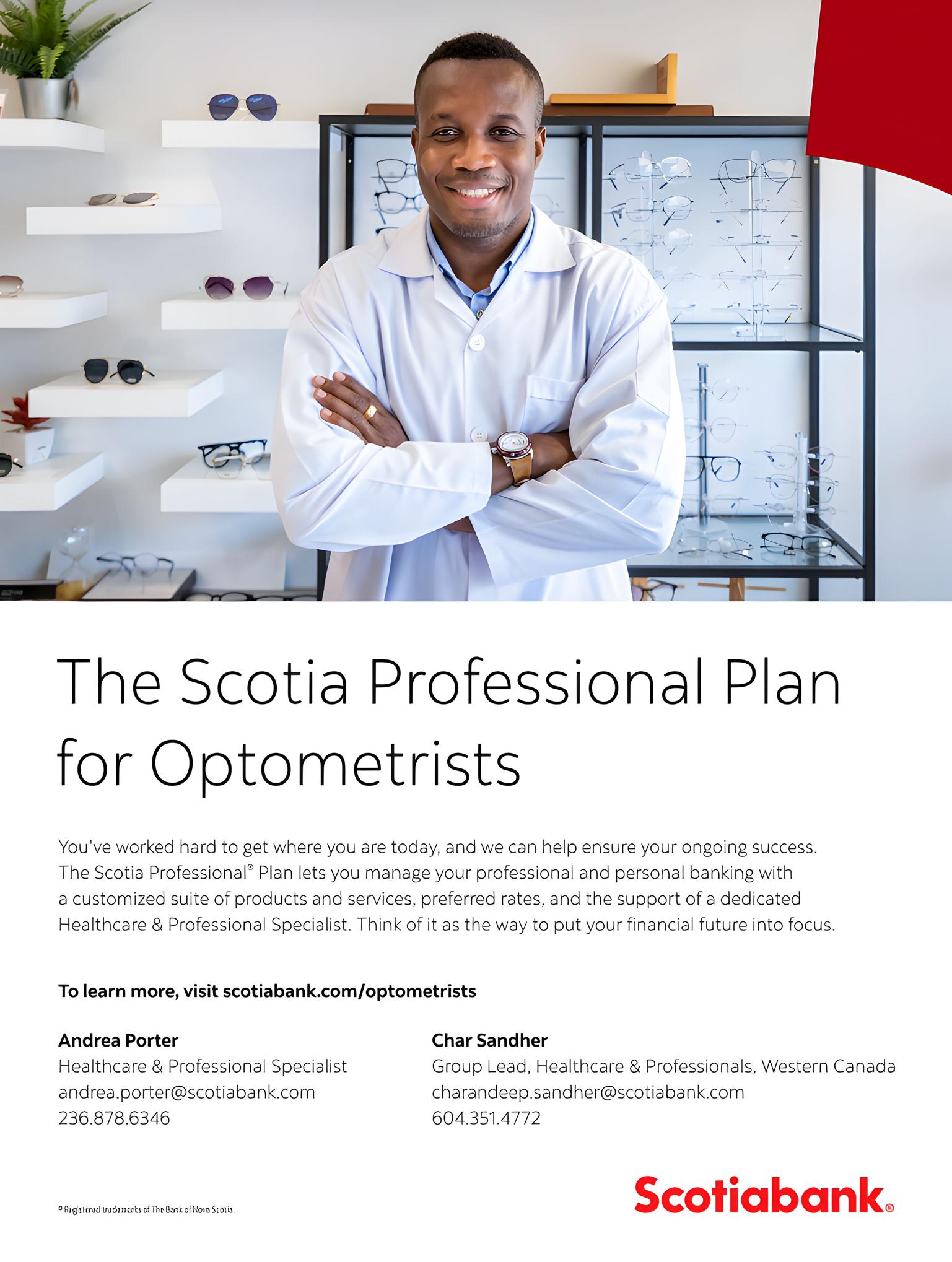
Fighting Blindness Canada (FBC) is the largest charitable funder of vision research in Canada. In its 50 years FBC has funded more than $45 million in critical visionsaving research and educational programs. Help your patients connect with other members of the sight-loss community and access the latest information about vision health and research with FBC’s educational resources.
VIEW POINT
View Point is an education series providing the latest information about vision health and research by way of virtual, hybrid and in-person events. 2024 topics include innovative treatments, inherited retinal dystrophies (IRDs), age-related macular degeneration (AMD), glaucoma and living well with an eye disease.
YOUNG LEADERS
The Young Leaders Program is a career-oriented initiative aimed at creating a brighter, more inclusive future for youth living with vision loss. The program provides young people in Canada, aged 15-35 who are blind or partially sighted, with the opportunity to gain access to resources, guidance and the support they need on the path to pursuing rewarding careers and finding fulfilling employment.
HEALTH INFO LINE
Our Health Information Line is here to help! Our knowledgeable staff can help direct your patients to trusted resources about disease information, genetic testing, clinical trials, treatment options, community supports and more. Email healthinfo@fightingblindness.ca or call 1.888.626.2995.
Visit: fightingblindness.ca
Stuart and Ali: Paying it Forward and Back

Volunteering often has a ripple effect, touching people in profound ways and motivating them to act in ways that benefit their local communities and beyond. This is the case with Stuart Matan Lithwick, Ph.D., and Ali Usman.
In 2019, Ali left his family to move to Canada by himself. When he was diagnosed with retinitis pigmentosa (RP) shortly afterwards, he felt very much on his own. He thought about quitting
university where he was studying science. It was recommended that he use a white cane, but he felt it would further stigmatize and isolate him.
“Following my diagnosis, I embarked on learning accessible lifestyle techniques,” Ali said. “However, from the early stages of my vision loss, a persistent fear loomed — the fear of appearing visibly disabled to those around me. The white cane represented a tangible symbol of my disability,
Ali Usman (L) and Stuart Matan Lithwick (R)
and my concerns were rooted in how others might perceive and interact with me.”
This changed when he attended a Young Leaders event hosted by Fighting Blindness Canada. When Ali saw the freedom and mobility that the white cane gave his peers, he felt empowered to get the training he needed to embrace his independence.
“The inclusion of a white cane in my daily life has been transformative, especially in travel and busy settings,” Ali said. “It allows me to navigate confidently and enhances my limited vision. Crucially, it has altered people’s reactions, fostering increased consideration in crowded spaces,”
Ali had the opportunity to meet Stuart through the Young Leaders Mentorship Program. Working with Stuart, a fellow scientist living with RP, Ali found the courage to continue his studies and to advocate for increased accessibility in his graduate program. In particular, Ali met with his Dean to discuss accessibility, and this meeting yielded a commitment to create a new annual scholarship to support students with disabilities, something that would now impact students for generations.
In turn, Ali inspired Stuart, who has continued his role as a mentor and continues to give back to the Young Leaders community in many ways.
“Working with Ali was a match made in heaven,” said Stuart, who is currently studying depression in the elderly at the Centre for Addiction and Mental Health in Toronto. “I actually left academia earlier than planned when I first got diagnosed. Not knowing of any scientists with a visual impairment, I did not think a further career in science would still be a possibility for me. I had to go on a 10-year journey of self-discovery before ultimately returning to pursue PhD studies.”
Ali and Stuart are prime examples of how volunteering and connecting with others who are experiencing similar challenges can forever transform people’s lives.
“The word that comes to me over and over and over again, when I think of the Young Leaders program is impact, straight up impact in a real way,” Stuart said.
He was inspired by how Ali worked to help others achieve their dreams through the establishment of the scholarship.
“It just really proved to me that you don’t need a big crowd, you just need a single person who is passionate about what they want to change. And this is what the Young Leaders program does more than just about anything else I’ve ever experienced.”
Visit FBC’s Young Leaders page to learn more about how you can get involved.

HOYA Vision Care’s Innovations Enhance Vision and Comfort
Advancing Eye Care: 22 | Eye Digest Magazine
HOYA Vision Care is dedicated to advancing vision technologies and empowering Eye Care Professionals (ECPs) to elevate their practices. By offering a collection of innovative lens technologies and recent product launches, HOYA aims to improve patient satisfaction and foster enduring loyalty. Our Integrated Dual Surface™ (iD) technology and Binocular Harmonization Technology™ (BHT) are key in providing personalized vision solutions that meet and exceed patient expectations across various visual environments. Let’s explore how these cuttingedge solutions can benefit your practice and enhance your patients’ visual experiences.
Personalized Vision with iD Technology
The Integrated Dual Surface™ (iD) technology is at the heart of HOYA’s innovation. This advanced technology uses the front and back of the lens to create a seamless progressive design that helps reduce distortion and eye rotation. This helps with adaptation and comfort. The lens design is then tailored to the individual wearer’s prescription, daily habits, and lifestyle, creating a more personalized feel. Unlike traditional lenses, which may only correct vision based on a standard prescription, iD technology compensates for frame fit to provide the same level of clarity you experience in the exam lane. Not only does this offer precise vision correction but it also provides superior comfort and ease of adaptation, which can reduce the number of follow-up visits and adjustments, saving time for both patients and practitioners.
Binocular Harmonization Technology™: Enhancing Comfort in Vision Correction
Binocular Harmonization Technology™ (BHT) addresses a common issue in vision correction: differing prescriptions between the two eyes leads to a prismatic imbalance, especially in progressive lenses. Almost 90% of the population has
different prescriptions for each eye, which creates challenges in achieving comfortable, balanced vision. By manipulating progressive powers through the corridor, BHT ensures that both eyes work together in harmony, providing comfort and visual balance in the near and intermediate reading areas.
By promoting natural and comfortable binocular vision, BHT alleviates common visual issues and significantly reduces the adaptation period. This leads to higher patient satisfaction and loyalty. When patients can see clearly and comfortably from the moment they put on their new glasses, they are more likely to return to your practice and recommend it to others.
Seamless Integration with iD LifeStyle® 4
Buildingonthesefoundations,HOYA’srecentlaunch of the iD LifeStyle® 4 features groundbreaking 3D Binocular Vision™ technology. This innovation is designed to meet the needs of modern, dynamic visual tasks. Whether your patients are reading, working on a computer, or engaging in outdoor activities, iD LifeStyle® 4 lenses offer unparalleled comfort and functionality.
The 3D Binocular Vision™ technology optimizes the lens design for real-world, three-dimensional viewing. This means that patients can experience significant improvements in visual accuracy and depth perception. For patients with different prescriptions in each eye, the same prismatic errors that appear within the corridor appear in the peripheral as well. 3D Binocular Vision helps compensate for these imbalances, drastically reducing peripheral deformation by up to three times. For patients with active lifestyles or those who perform visually demanding tasks, these lenses can make a noticeable difference in their daily lives and enhance your patients’ visual experiences across a wide range of activities.
Eye Digest Magazine | 23
Unmatched Clarity and Durability: Elevating Patient Comfort and Confidence
Lens clarity and durability are crucial factors in patient satisfaction. HOYA’s advanced AntiReflective (AR) treatments are designed to minimize glare, protect from scratches, repel dust, and resist smudging. These features enhance both visual clarity and lens longevity. Patients will appreciate lenses that remain cleaner and clearer for longer, reducing the need for frequent cleaning and maintenance.
HOYA’s substrate-matching process ensures that the AR treatment bonds effectively to the lens, improving durability and providing a clearer optical path. By uniquely preparing each lens with a primer coating according to its index, HOYA can ensure that the AR layers effectively adhere to the lens, offering stronger durability and consistency for our AR treatments. Offering HOYA’s AR technology in your practice means your patients will enjoy lenses that remain cleaner and clearer for longer. This reduces maintenance and remakes, which will boost satisfaction.
The latest Super HiVision® Meiryo™ EX4™ treatment offers less reflections and longer durability compared to previous generations. It provides unparalleled resistance to scratches, dust, and smudges, and is highly water-repellent, making the lenses easier to clean. This enhancement maintains excellent clarity and extends the lifespan of the lenses, setting a new standard of care and reinforcing patient trust and loyalty.
Sensity® Photochromic Technology: Seamless Adaptation to Light
Adapting to varying light conditions is a significant concern for many eyeglass wearers. According to a recent Vision Council study approximately 40%
of consumers are interested in photochromic lenses, and almost 90% of photochromic users will repurchase. HOYA’s Sensity Photochromic lenses address these issues by intelligently adjusting to changes in light. These lenses darken in bright sunlight to reduce glare and return to clear indoors, providing continuous comfort and protection against UV and blue light.
Nearly 70% of people report light sensitivity in various conditions. By providing Sensity lenses, you cater to a critical need, enhancing wearers’ comfort and encouraging adherence to eyeglass use. This can lead to higher patient satisfaction and loyalty. Patients who experience seamless adaptation to changing light conditions are more likely to appreciate the advanced technology in their lenses and feel more comfortable wearing their glasses throughout the day
Conclusion
HOYA Vision Care’s new iD LifeStyle® 4 lenses incorporate advanced technologies like 3D Binocular Vision™, iD Technology, and Binocular Harmonization Technology™ to enhance visual health. These innovations help ensure patients receive comfortable and precise vision correction tailored to their unique needs. HOYA’s lenses are designed to improve visual clarity, reduce eye strain, and adapt seamlessly to various activities andlightconditions,enhancingoveralleyecomfort and health. By choosing HOYA lenses, wearers can experience better vision quality and enjoy lenses that stay cleaner and last longer. These advancements not only improve how people see the world, but also ensure that their vision care is as comfortable and effective as possible. Staying informed about the latest in vision technology allows individuals to make the best choices for their eye health, leading to a better quality of life through improved vision.

24 | Eye Digest Magazine

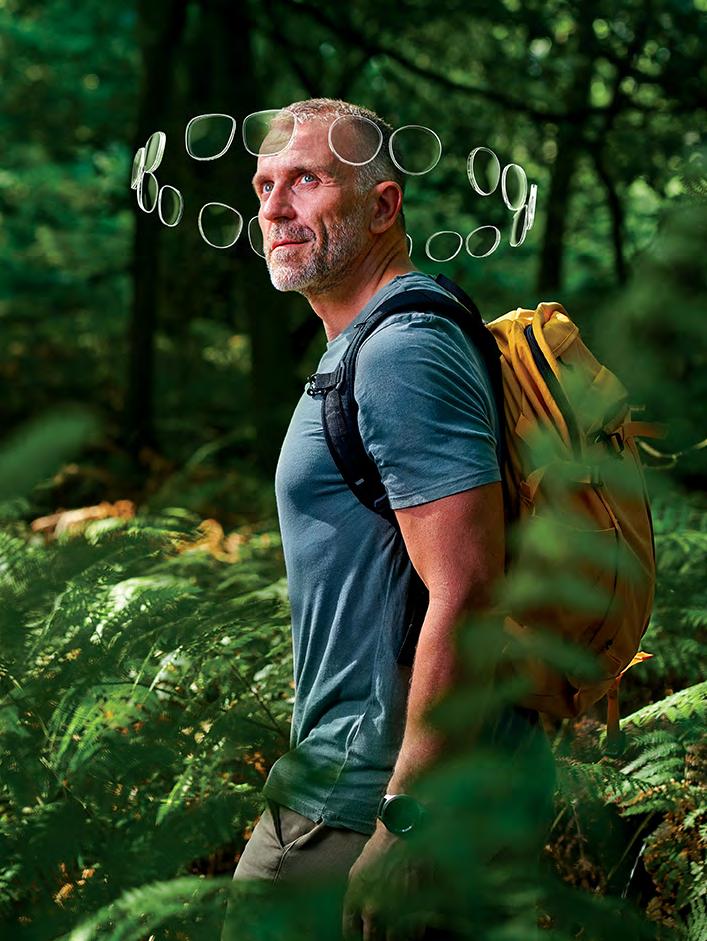
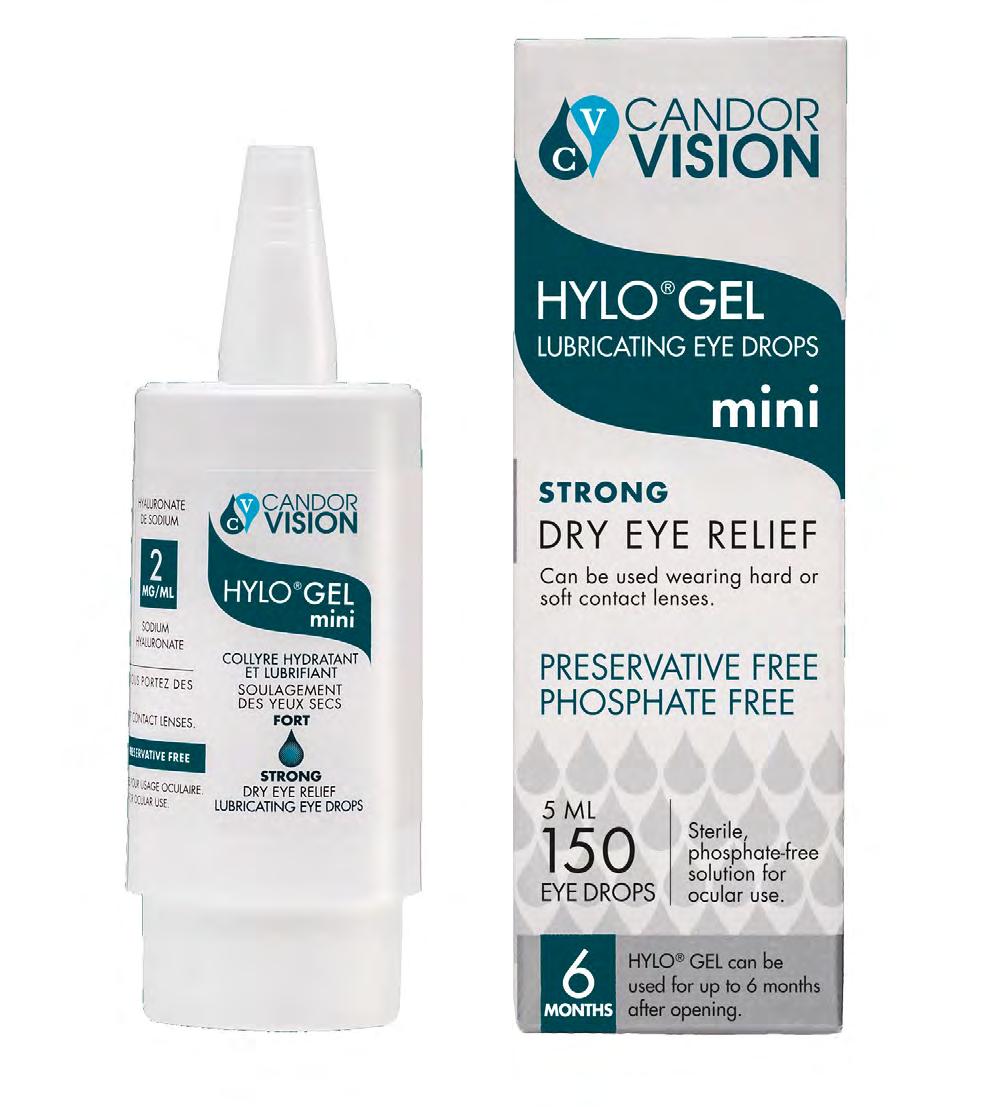

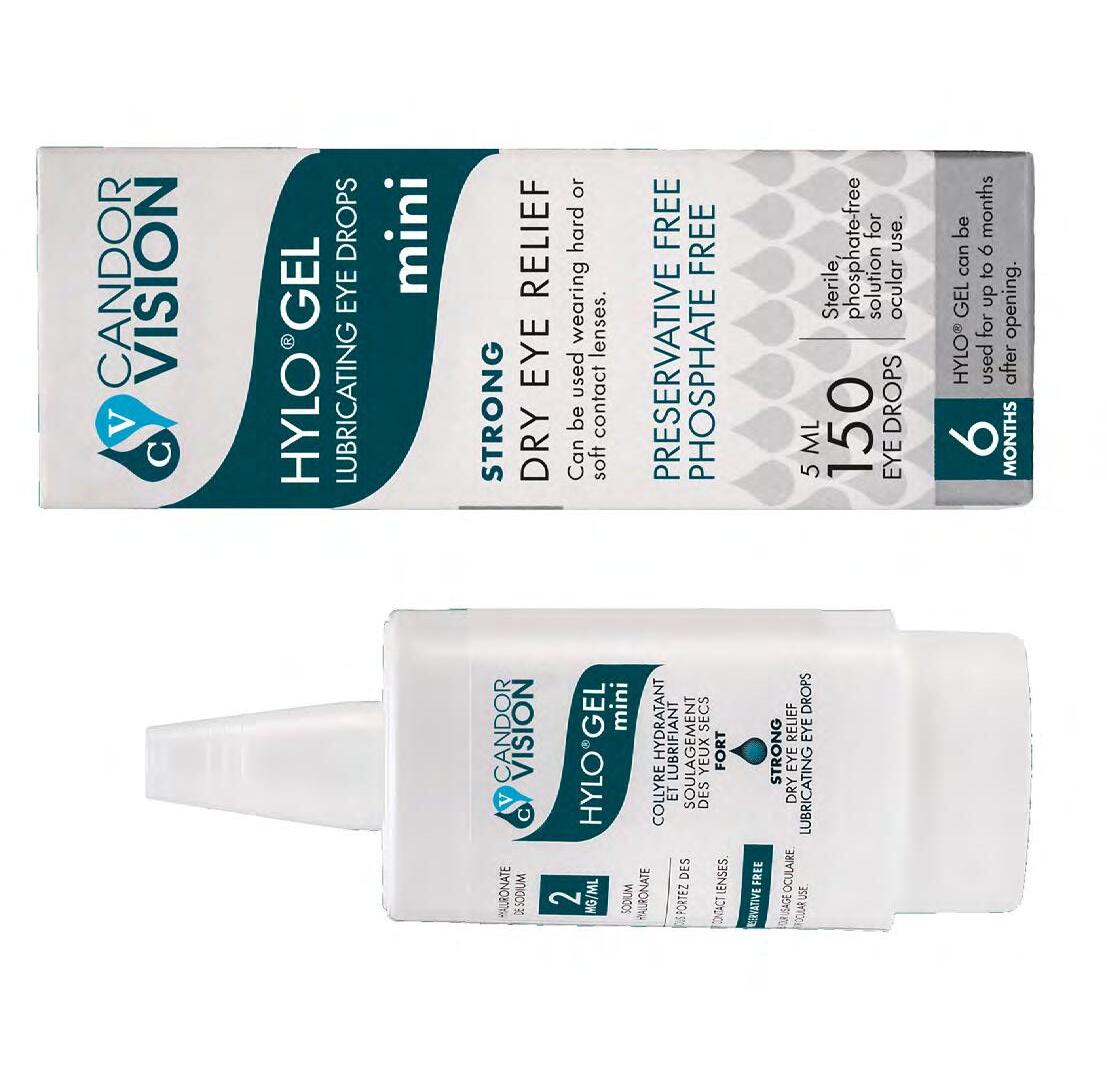





Snibson
JM,
CG,
AJ. Ocular surface residence times of artificial tear solutions. Cornea. 1992 Jul;11(4):288-93; Jones L, Downie LE, Korb D, Benitez-Del-Castillo JM, Dana R, Deng SX, Dong PN, Geerling G, Hida RY, Liu Y, Seo KY, Tauber J, Wakamatsu TH, Xu J, Wolffsohn JS, Craig JP. TFOS DEWS II Management and Therapy Report. Ocul Surf. 2017 Jul;15(3):575-628; Data on file.
High molecular
hyaluronate for unparalleled HYLO® feel
strong, immediate, long-lasting relief PRESERVATIVE FREE PHOSPHATE FREE TOP GERMAN TECHNOLOGY
GR,
Greaves
JL,
Soper
ND, Tiffany
Wilson
Bron
NEW additional starter pack size at an attractive starter price Strong lubrication that won’t compromise visual acuity
weight sodium
High concentration for




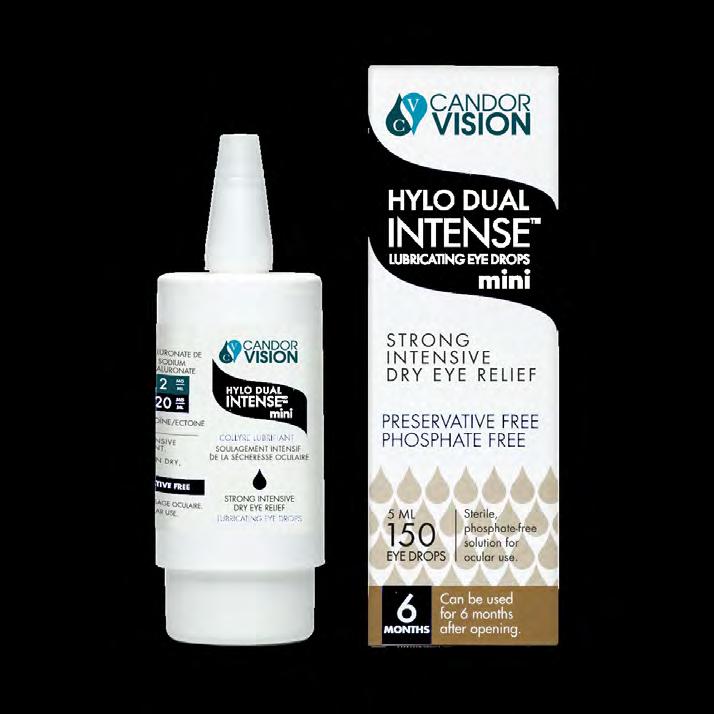




2024 CANDORVISION | A DIVISION OF CANDORPHARM INC. | CP 23073 MONTREAL, CANADA H4A 1T0 | T: 5143805270 Graf, R. et al. Clinics in Dermatology 2008 26, 326-333; Brünger, J. and Driller, H., Skin Pharmacol Physiol 2004; 17:232-237; Harishchandra, R.K. et al. Biophys. Chem 2010, doi:10.1016/j.bpc.2010.02.007; Dwivedi, M. et al. Part A: Natural meibomian lipid lms, Biochim. Biophys. Acta (2014), http://dx.doi.org/10.1016/j.bbamem.2014.05.011, Part B: Arti cial lipid lms, Biochim. Biophys. Acta (2014), http://dx.doi.org/10.1016/j.bbamem.2014.05.007; Data on file candor vision.com LEARN MORE: Start your patients strong and intensive . Order now! Jump early at chronic dry eye and inflammation with HYLO DUAL INTENSE mini ! Intensive lubrication of chronically dry eyes Relieves inflammatory symptoms: burning and itching Long-lasting for fewer daily applications New additional starter pack size at an attractive starter price
No More
Why ECPs must speak up for “Say Nothing” patients
By Dr. Carla Mack
Picture this:

how their current contact lenses feel. they go. Same familiar lenses in hand.
the twist: if they are experiencing some level of discomfort, chances are high they’re not telling you about it. In a recent survey, 47% of contact lens wearers said they accept discomfort as a normal part of wearing contact lenses,1 and Nothing” patients blame their own eyes for discomfort, rather than the lenses.1 issues to the environment, the wearing time… anything but the contact lenses.1
Patients often don’t have a frame of reference for what great comfort and they settle for a less-thanacceptable lens experience as a result.
discussing discomfort.1 69% don’t feel knowledgeable enough to discuss discomfort.1
 Dr. Carla Mack is Global Head of Professional
Dr. Carla Mack is Global Head of Professional
your “Say Nothing” patients. All you have to do is ask them “Are you happy with the comfort of your lenses?” If the answer is no, your comfort conversation has begun.
Tell them about the ultimate comfort the TOTAL® family of Water and their next comfort conversation might be the last one they ever have to have.
in the conversation
as comfort advocates cannot be understated. We also want to empower them to engage in comfort
patients’ biggest comfort advocates.
teach wearers how to apply and remove contact lenses, may be seen as more approachable and relatable. Patients may be more likely to open up about discomfort with them. All your team needs to do is ask.
Patients are interested! 80% of contact lens wearers would change lenses if more comfortable options were made available to them.2
Innovating for
TOTAL® brand contact lenses are
Gradient lenses. All TOTAL® brand contact lenses approach 100% water at the outermost surface*, so all that touches the eye is a gentle cushion of moisture.3-6 You can delight your patients with the exceptional lens-wearing experience of the TOTAL® family of contact lenses.
Just think of how many silent massive opportunity to uncover and help address these issues with a lens option that will allow them to see their best, comfortably – and a chance to help new and existing contact lens wearers have a positive experience.
Once patients feel the joy and patients, they’ll wonder why they didn’t speak up sooner.
*Based on in vitro measurements of unworn lenses.
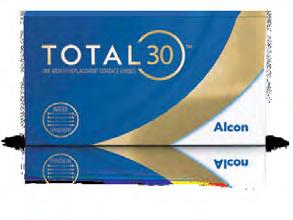
References: 1. Based on an online survey of 2,006 contact lenses wearers and 200 Eye Care professionals in the U.S., Germany, Italy 2.Online consumer survey of 1,010 current contact lens wearers ca December 2021 (France n=200, Germany n=199, Italy n=209, Australia n=200 and South Korea n=202). Contact Lens Anterior Eye. 2012;35(Suppl 1):e14. 4. Angelini TE, Nixon RM, Dunn AC, et al. Viscoelasticity and mesh-size at the surface of hydrogels characterized with microrheology. Invest Ophthalmol Vis Sci. 2013;54:E-abstract 500. 5 6.In vitro analysis of lens oxygen permeability, water content, and surface imaging;

Alcon Inc. CA-T30-2400037
©2024

SEAMLESS VISION1 WITH A LENS THAT FEELS LIKE NOTHING, EVEN AT DAY 302
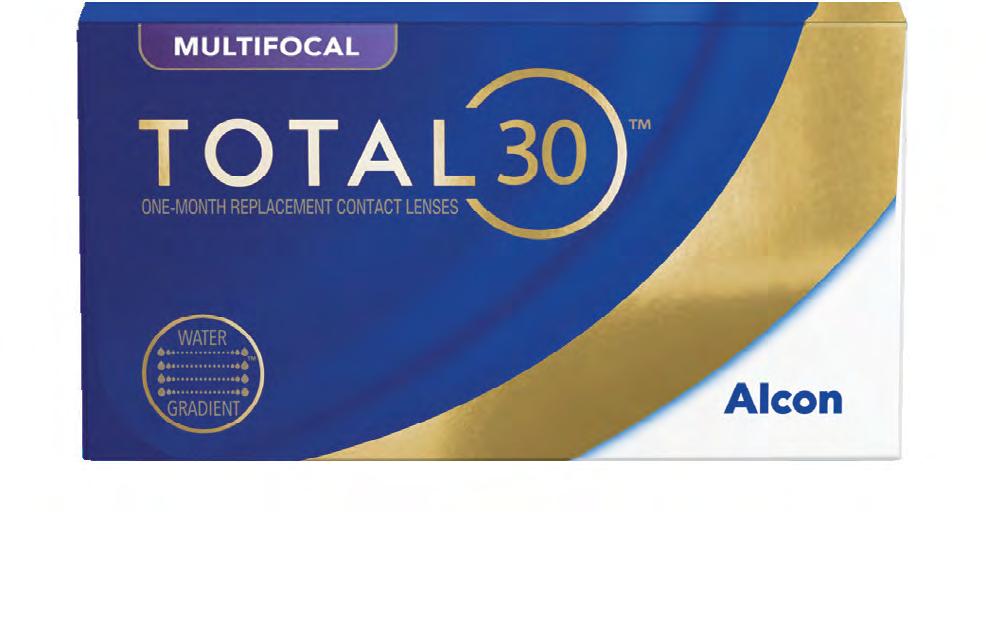
Recommend TOTAL30® Multifocal contact lenses for TOTAL comfort 2 and seamless vision, near through far1

CELLIGENT® Technology helps resist deposits and bacteria for a clean lens5-8**
* With two lenses or less per eye, at the initial fitting visit.
** Based on in vitro studies on unworn lenses.

Water Gradient helps deliver outstanding comfort2
Blue-Violet Light Filtering † Filters 34% of Blue-Violet Light (BVL) rays9†
† There is no demonstrated clinical benefit to a 34% reduction in blue-violet HEV light at wavelengths below 450 nm. BVL testing done on lehfilcon A sphere lenses.
†† UV absorbing contact lenses are NOT substitutes for protective UV absorbing eyewear, such as UV absorbing goggles or sunglasses because they do not completely cover the eye and surrounding area. The patient should continue to use UV absorbing eyewear as directed.
References: 1. Alcon data on file, 2022. 2. In a clinical study wherein patients used CLEAR CARE® solution for nightly cleaning, disinfecting, and storing; Alcon data on file, 2021. 3. Merchea M, Evans D, Kannarr S, Miller J, Kaplan M, Nixon L. Assessing a modified fitting approach for improved multifocal contact lens fitting success. Paper presented at Optometry’s Meeting, the 121st Congress of the American Optometric Association; June 20-24, 2018; Denver, CO. 4. Bauman E, Lemp J, Kern J. Material effect on multifocal contact lens fitting of lenses of the same optical design with the same fitting guide. Poster presented at: British Contact Lens Association Clinical Conference & Exhibition; June 9-11, 2017; Liverpool, UK. 5. In vitro evaluation of bacterial adherence in commercial lenses: Alcon data on file, 2020. 6. In vitro evaluation of bacterial biofilm in commercial lenses: Alcon data on file, 2020. 7. In vitro evaluation of lipid deposition for lehfilcon A and commercial lenses using 3D confocal imaging; Alcon data on file, 2021. 8. Ishihara K, Fukazawa K, Sharma V, Liang S, et al. Antifouling silicone hydrogel contact lenses with a bioinspired 2-methacryloyloxyethyl phosphorylcholine polymer surface. ACS Omega. 2021;6:7058-7067. 9. Laboratory assessment of ultraviolet and visible light transmission properties of lehfilcon A sphere contact lenses using spectrophotometer; Alcon data on file, 2020.
See product instructions for complete wear, care and safety information.
©2023 Alcon Inc. CA-T3M-2300002

PRECISION PROFILE™
Proven 96% fit success1,3,4* and seamless vision, near through far1
Scan to learn more

1,3,4*
Intermediate
Distance Near
NEW
OFFER YOUR PRESBYOPIC PATIENTS
† † †

Caring for Vision, Caring for People:
The Essence of Patient Care
By Kiljon Shukullari HR Advice Manager at Peninsula Canada
30 | Eye Digest Magazine

The success of a clinic doesn’t only depend on technical expertise but also creating genuine connections with patients.
At the heart of patient-centred care lies the understanding that each individual who walks through your clinic has their own distinct needs and concerns. Recognizing this, employers can create a work environment where every team member is able to prioritize and cater to the wellbeing of each patient.
First and foremost, cultivating a patient-centered culture begins with recruitment and training. Look for individuals who not only excel in clinical skills but also possess exceptional communication abilities and empathy. By investing in ongoing training programs focused on patient interaction and empathy-building exercises, employers can ensure that team members are equipped with the tools to build meaningful connections with patients. Retention has become an issue for many industries and this is one of the ways to improve talent retention.
Staff need to be equipped with the necessary resources and support to deliver exceptional care. This includes investing in cutting-edge technology to enhance diagnostic accuracy and efficiency, as well as creating comfortable and welcoming environments that put patients at ease. By prioritizing these elements, it will not only elevate the patient experience but also foster loyalty and trust within the community.
Eye Digest Magazine | 31

Visiting the doctor’s office isn’t always something people look forward to, especially if they feel anxious or uncertain about their eye health. Whether they’re experiencing vision correction or undergoing new treatments, be mindful of how the patient is feeling about their eye health. Employers should encourage their team to take the time to carefully listen to the patients concerns by providing reassurance and support each step of the way.
If you’re unsure what needs to be improved, why not ask the patients themselves? Establish a feedback mechanism for patients postappointment. It could be a simple conversation after the appointment or a follow up call after a few days.
Why is caring for patients so important?
Firstly, it ensures the optimal health and wellbeing of patient’s eyes. By prioritizing patient care, you can promptly identify and address any eye issues, preventing potential complications and safeguarding vision health. Additionally, establishing a caring relationship with patients fosters trust and comfort, encouraging open communication, adherence to treatment plans, and regular check-ups. This ultimately leads to better treatment outcomes, overall patient satisfaction and loyalty.
Patient care extends beyond just treating eye conditions; it involves educating patients about their eye health and the importance of preventive measures. When patients feel valued and supported by their optometrist, they are more likely to adopt healthy practices, ask clarifying questions, and follow treatment plans, leading to improved long-term eye health.
Furthermore, prioritizing patient care helps build a positive professional reputation within the community. Satisfied patients are more likely to recommend their optometrist to others, leading to referrals and a strong practice reputation. Ultimately, optometrists have a professional and ethical responsibility to prioritize the wellbeing of their patients above all else. By caring for their patients, optometrists uphold the highest standards of ethical practice and fulfill their duty to provide quality eye care.
Patient-centered eyecare is a commitment, one that employers should take seriously. By fostering a culture of empathy, investing in staff, and prioritizing the needs of our patients, we not only enhance the quality of care provided but also enrich the lives of those we serve.
32 | Eye Digest Magazine
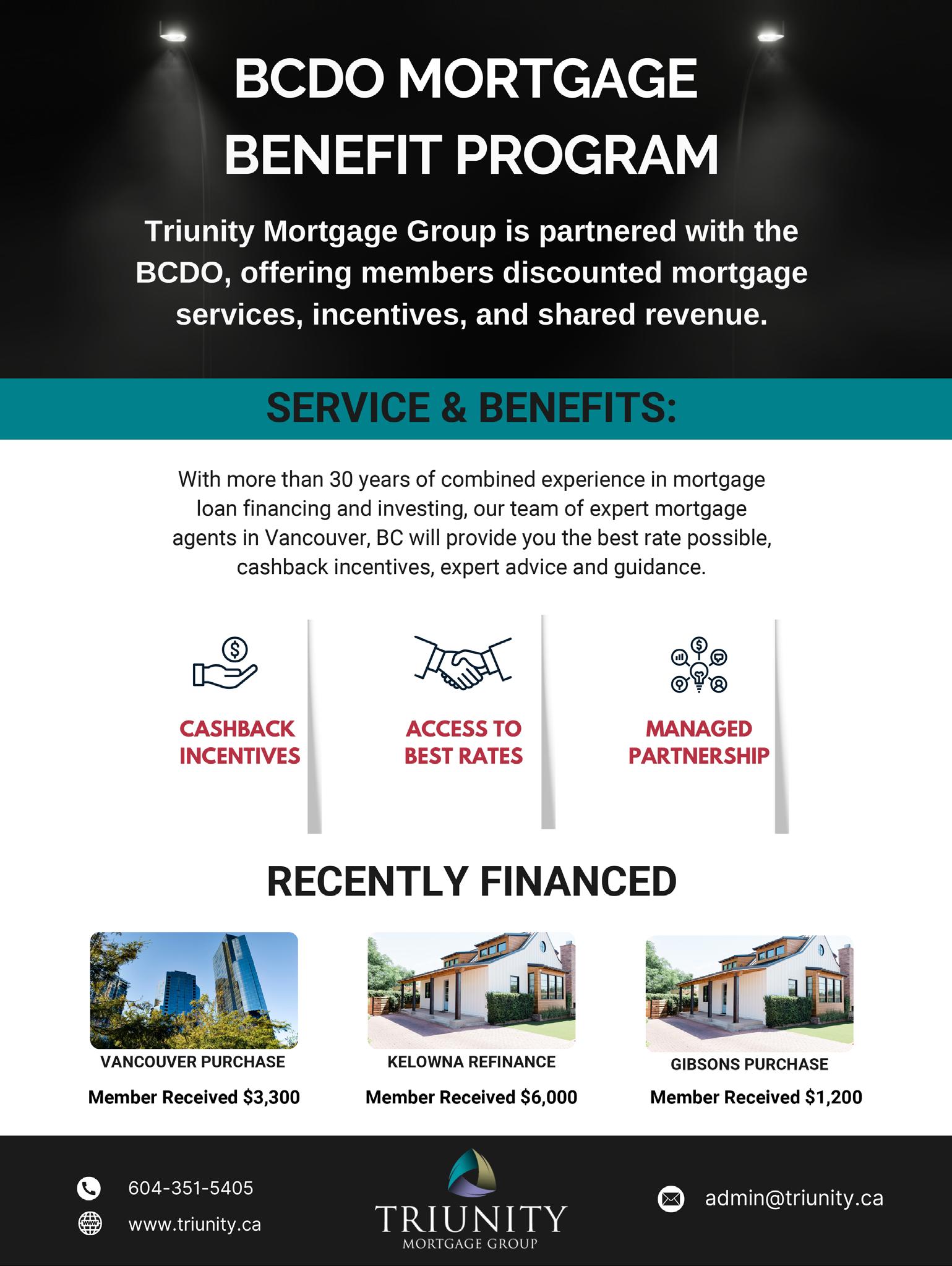

Highlights Reel: BCDO 2024
Our 2024 Annual Conference saw an impressive attendance of over 500 people, all taking advantage of a weekend of continuing education, hands on workshops, networking, our popular tradeshow, and some great food! The event was hosted at the Hyatt Regency Vancouver on April 5 – 7, 2024.
The program offered nearly 40 hours of COPEaccredited CE hours for optometrists, 12 hours for optometric staff. With a wide variety of topics from practical tips on managing binocular vision and TBI in primary care settings, updates on dry eye and cosmetics, to laser workshops, we could talk all day about all the great events of the weekend, but here are some highlights.
Awards Lunch
We love taking the opportunity to recognize and celebrate our members who have made outstanding contributions to optometry. Once again, a huge congratulations to our award recipients:
Optometrist of the Year
Dr. Gurpreet Leekha
This award honors an individual who has made significant contributions to the advancement of optometry.
Dr. Leekha is not only the owner of three optometry clinics, but he also served as the BCDO President from 2015 to 2017. During his tenure, he advocated passionately for oral scope expansion, telehealth privileges, and expanded billing codes.
He has also played a vital role in BCDO’s Public Relations Committee for many years and has lent his expertise as a consultant and educator for several optical companies including the Canadian Optometry Group.
If this is not enough, he has been mentoring optometry students since 2006, and has selflessly participated in eye care missions through VOSH and OneSight to Chile and Mexico.
Young Optometrist of the Year
Dr. Janice Luk
This award honours BCDO members who have been practicing for less than 10 years and have demonstrated outstanding leadership skills both within the profession and in the community.
Dr. Luk has done volunteer work with fighting blindness and cycle of sight raising funds for research for various eye diseases. She also volunteers her time on BCDO’s membership and CE committee. She is an active social media influencer, passionate about dry eye disease management and educating the public on safe practices around eye lash extensions. She has also helped develop the ocular hygienist courses at the Dry Eye Summit.
Optometry Representative of the Year
Ms. Alannah Bruns
This award honours an individual who has gone above and beyond in supporting our doctors.
Known for her integrity, professionalism, and remarkable commitment to optometrists, Alannah has elevated dry eye care for our clinics and for our patients through her partnership with Sun Pharma.
Optometric Assistant of the Year Award
Ms. Alicia Jeffery
This award celebrates an individual who has provided exceptional service to our doctors.
Alicia is the pioneer ocular hygienist and has been an integral part of Cowichan Eyecare for nearly 15 years. Her Colleagues describe her as a dependable teammate, a friend, and a marvel at multitasking while consistently surpassing patient expectations.
Eye Digest Magazine | 35

BCDO Award Winners

DR. GURPREET LEEKHA
Optometrist of the Year
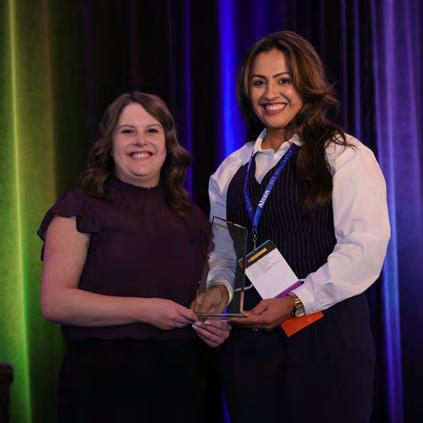
MS. ALANNAH BRUNS
Optometry Representative of the Year
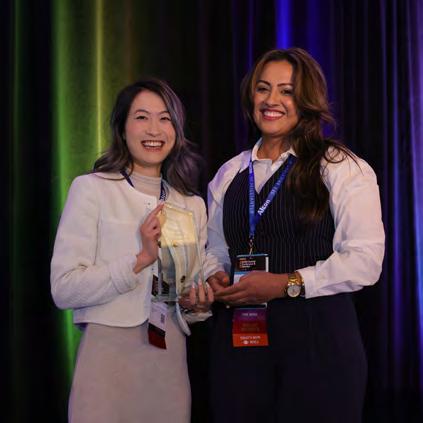
DR. JANICE LUK
Young Optometrist of the Year

MS. ALICIA JEFFERY
Optometric Assistant of the Year
36 | Eye Digest Magazine
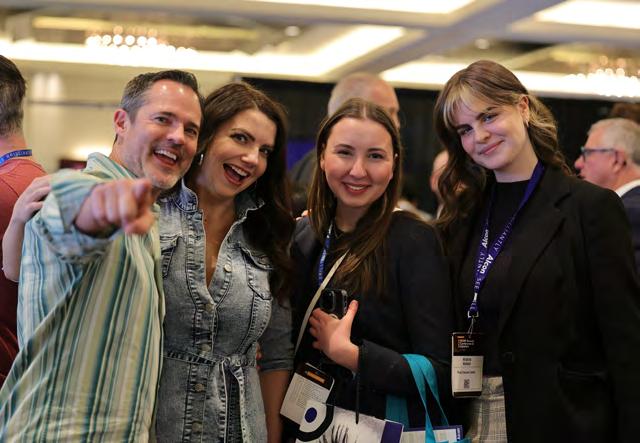

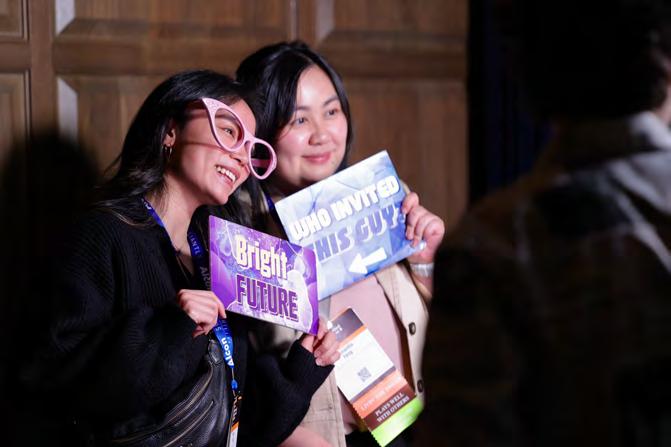



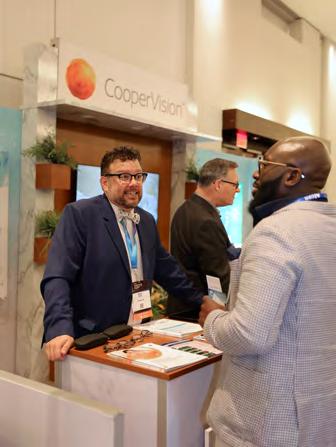
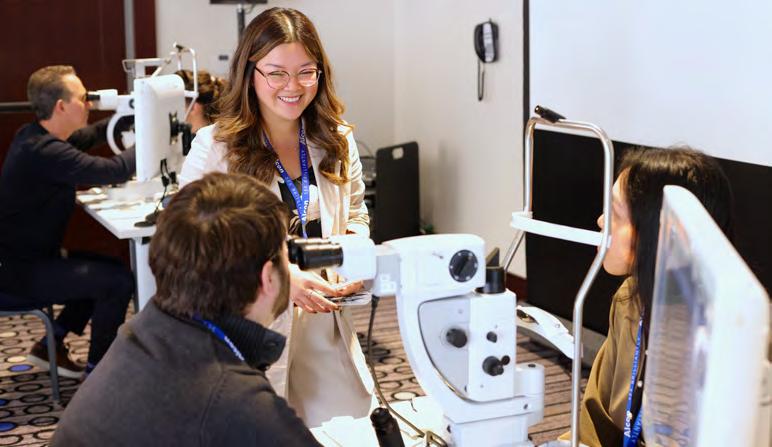
BCDO ANNUAL CONFERENCE & OPTOFAIR Eye Digest Magazine | 37
2024 OPTOFAIR
OPTOFAIR was yet again a lively afternoon which provided the opportunity for delegates to connect with over 50 vendors and suppliers. Congratulations to the raffle prize winners!
Friday Night Trivia
Who knew Optometrists were such a competitive bunch! Teams went head to head at the Bullock & Butch to battle it out for the title of Trivia Winners. Congratulations to the victorious team.
Cocktail Reception & Annual Conference Gala
We were transported to a summer holiday at our upscale tropical themed Gala, complete with a seafood buffet, dancers, and incredibly popular candy bar. D6 Bar & Lounge at the JW Marriott Parq Vancouver offered the perfect setting for celebrating a weekend of learning and connecting.
The BCDO team looks forward to building on the success of the 2024 Annual Conference, with preparations already underway for a bigger and better conference at our brand new location, JW Marriot Parq, next year.
See you there!
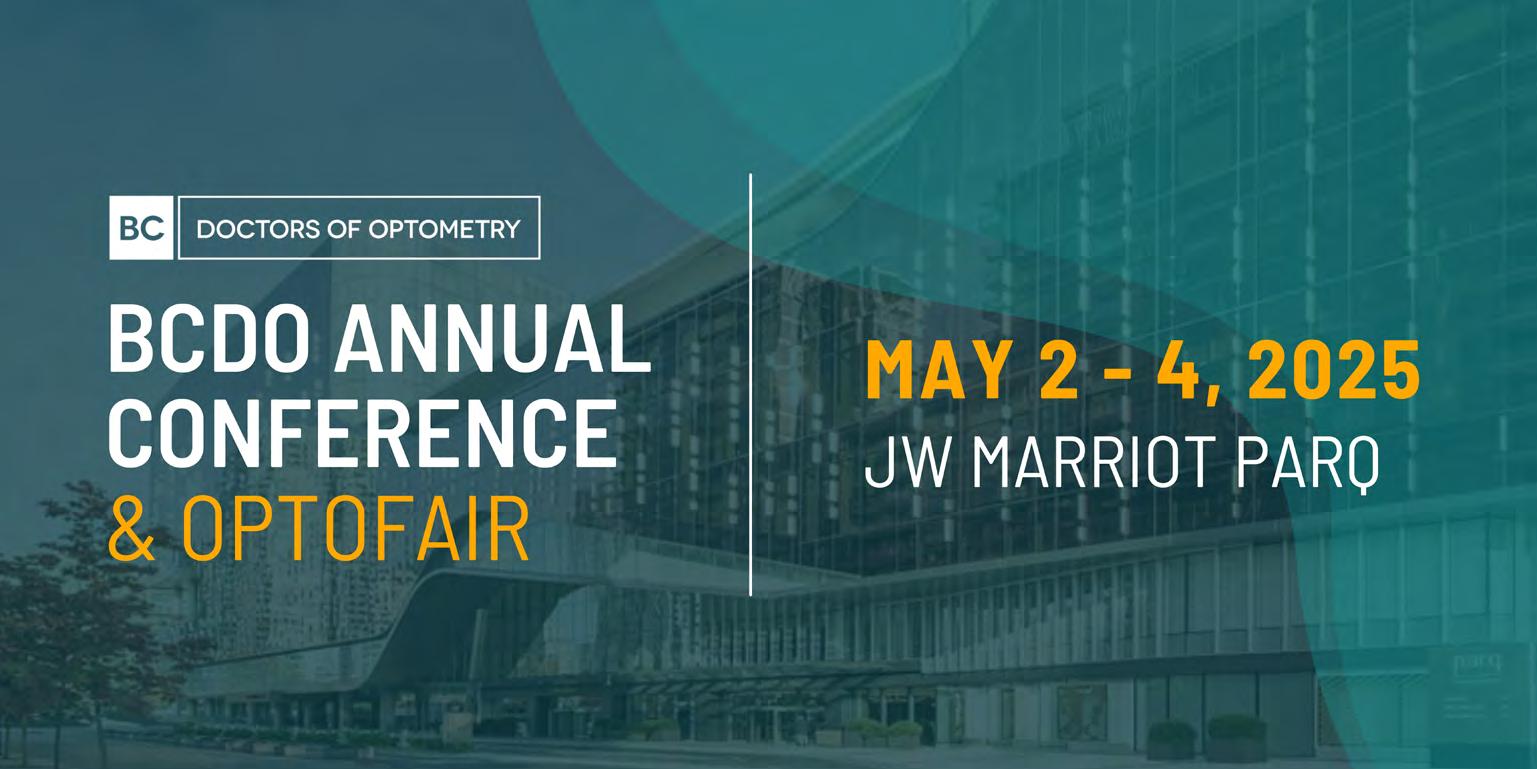
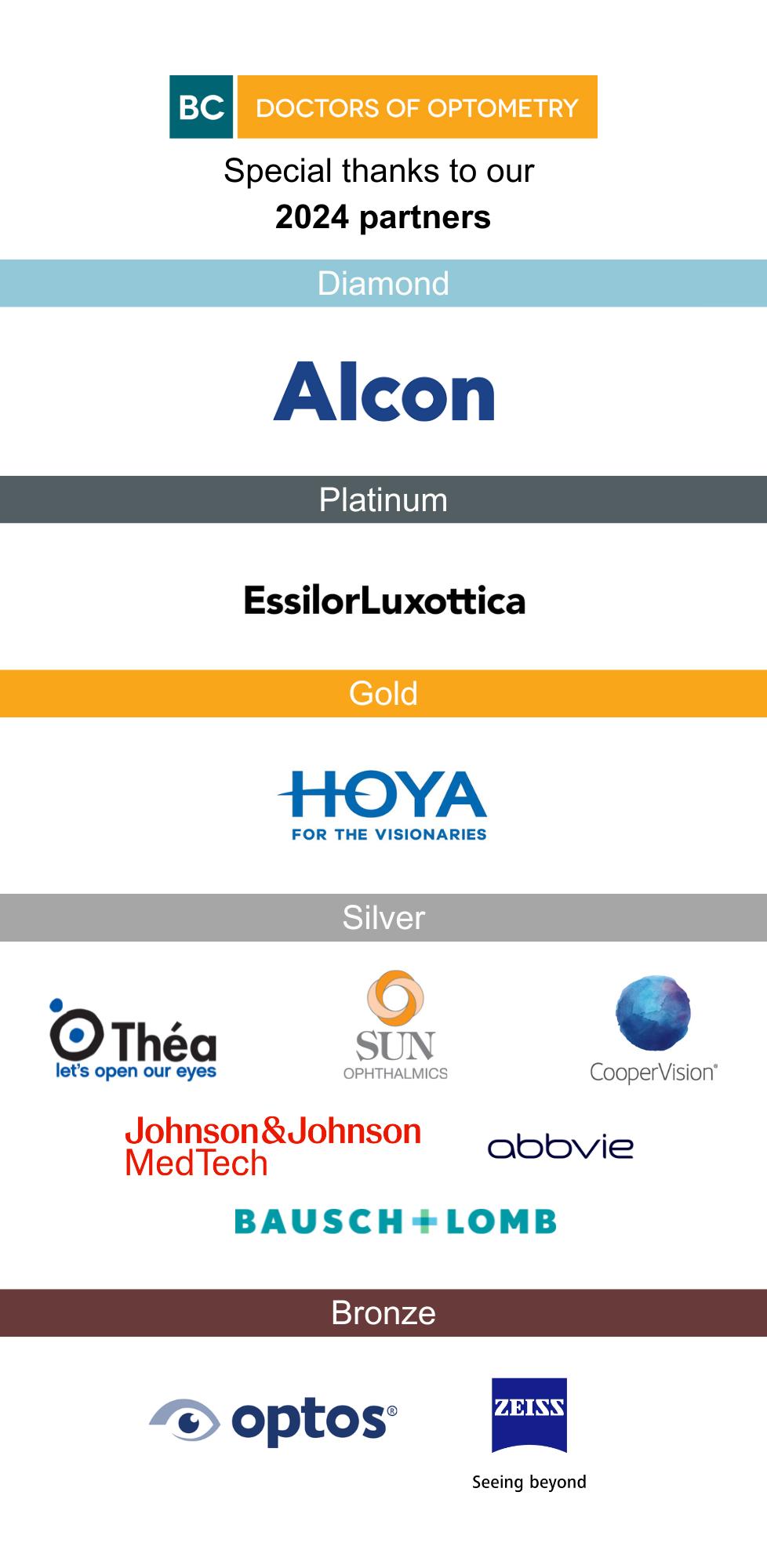
Optomap: Essential on Every Patient, All Ages, Asymptomatic
“After seeing so many things that might have been otherwise missed - even when someone presents without symptoms – I am convinced that optomap imaging is important for every patient regardless of health or age.”
Jasmine Said, OD

When 29-year-old Brent came to see Dr. Jasmine Said, he was healthy, asymptomatic and anticipating a routine eye exam and possibly a prescription for glasses. So initially, he refused an optomap exam based on his apparent good health and therefore, an unnecessary expenditure.
However, Dr. Said asked him to reconsider. “He was healthy and came in complaining of a slight blur at distance.” Brent’s refractive error did not predispose him to an increased risk of retinal detachment nor did he present with any signs or symptoms which might have caused Said to suspect an issue.
Yet Said believes single capture Ultra-Widefield is essential for every patient regardless of age or health. Brent acquiesced and the subsequent image revealed a small retinal hole, temporally, in the left eye.
Said showed Brent the image and explained how if undetected, unmonitored or untreated, a retinal hole could lead to a retinal detachment and
blindness. “It is one thing to say it and another to see it.” She added “Brent was very surprised and very thankful. He commented to me that it was the best additional fee he had ever spent.”
Said reiterated the value of being able to capture a comprehensive view of 82% of the retina in a single image and the importance of imaging every patient. In addition to immediately identifying pathology, such as Brent’s, she assets that she is able to track and monitor each patient’s health over time and convey what she sees to them with ease and efficiency.
“Often I am asked by patients if I really think optomap imaging is necessary. The answer is always yes.”
Said emphasized
40 | Eye Digest Magazine


www.optos.com 800-854-3039 optomap Delivering High-resolution, 200° Ultra-widefield (UWF)™ Retinal Images in a Single Capture Fundus Camera - 45° I n d i r e c t O p h t h a l m o s c o p e - 3 0 ° Slit Lamp- 90° W i d e f i e l d S L O - 1 1 0 ° Direct Ophthalmoscope - 5-10°
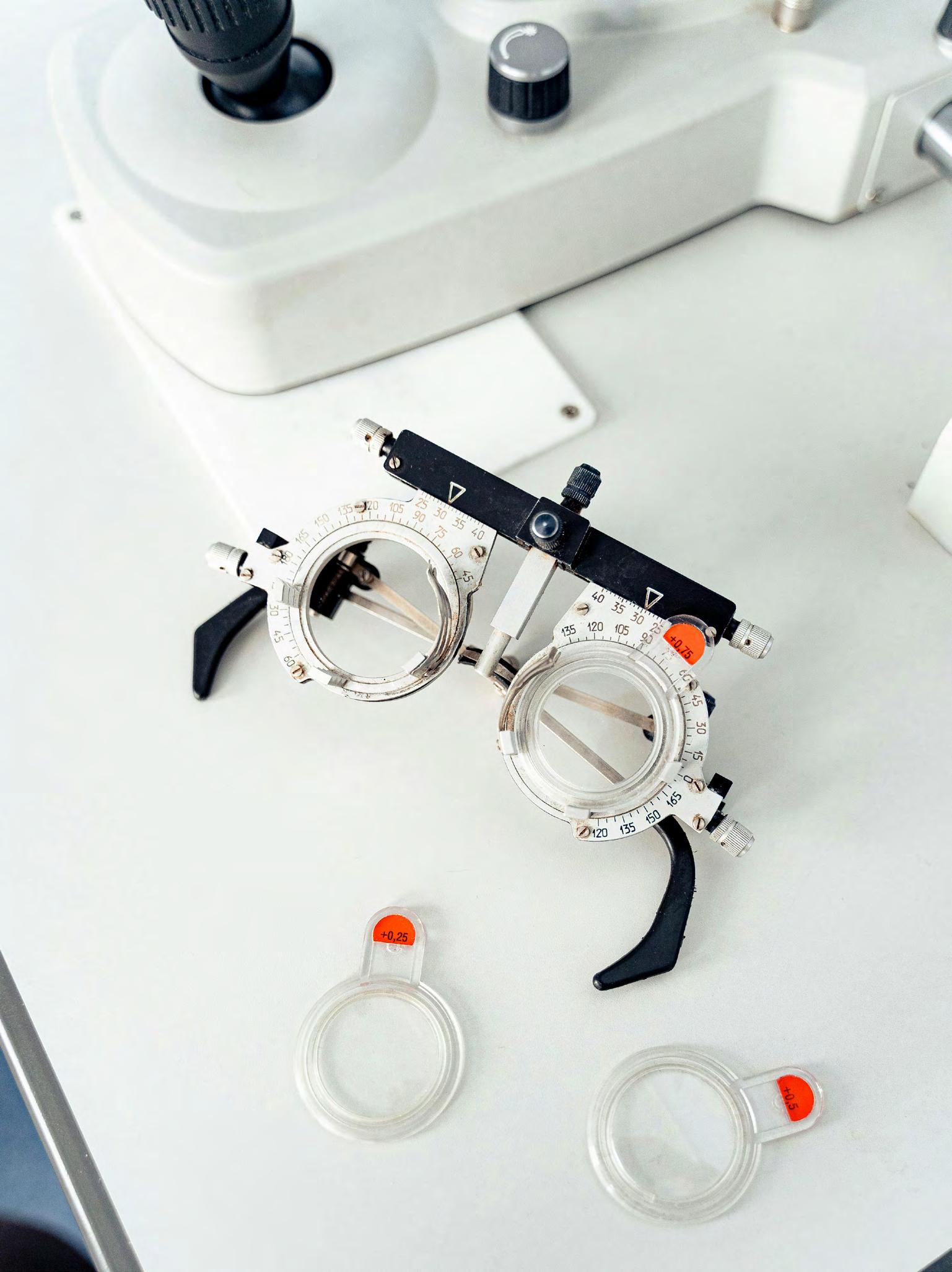






































 Dr. Carla Mack is Global Head of Professional
Dr. Carla Mack is Global Head of Professional
































